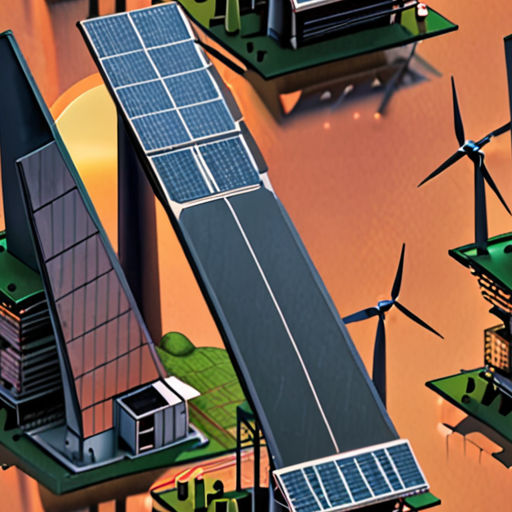As the world grapples with the challenges of climate change, environmental degradation, and sustainable development, harnessing waste to renewable energy has emerged as a vital strategy for creating a cleaner, greener future. With the global population projected to reach 9.7 billion by 2050, the need to convert waste into valuable resources has never been more pressing. By leveraging cutting-edge technologies and innovative approaches, we can transform waste into a reliable source of renewable energy, reducing our reliance on fossil fuels and mitigating the impacts of pollution.

Turning Waste into Renewable Energy
We believe that transforming waste into renewable energy is crucial for reducing our environmental footprint and mitigating climate change.
-
Biomass Conversion
Biomass conversion involves breaking down organic matter, such as food waste, agricultural residues, and sewage sludge, into biofuels, heat, and electricity.
-
Pyrolysis
Pyrolysis is a thermal decomposition process that converts biomass into bio-oil, syngas, and biochar.
-
Gasification
Gasification is a process that converts biomass into synthesis gas, which can be used to produce electricity, heat, and transportation fuels.
-
-
Waste-to-Energy Plants
Waste-to-energy plants burn municipal solid waste to produce steam, which drives turbines to generate electricity.
-
Benefits
Waste-to-energy plants offer several benefits, including reduced greenhouse gas emissions, decreased landfill waste, and increased energy production.
-
Challenges
However, these plants face challenges such as high capital costs, air pollution concerns, and public acceptance issues.
-
-
Sustainable Practices
Implementing sustainable practices, such as recycling, composting, and reducing waste generation, is essential for minimizing waste sent to landfills and promoting renewable energy production.
-
Recycling
Recycling helps conserve natural resources, reduces landfill waste, and saves energy compared to producing new materials from raw resources.
-
Composting
Composting turns organic waste into nutrient-rich soil amendments, reducing the need for synthetic fertilizers and promoting sustainable agriculture.
-
By adopting these approaches, we can effectively convert waste into renewable energy, mitigate climate change, and promote sustainable development.
Is WastetoEnergy Renewable?
As someone who’s passionate about sustainable living and eco-friendly technologies, I’m often asked whether WastetoEnergy (WtE) is a renewable energy source.
- While WtE is indeed an alternative to fossil fuel-based energy production, it’s not considered a renewable energy source in the classical sense.
- The reason for this is that WtE relies on burning waste materials to generate electricity, which isn’t a natural or infinite resource like solar or wind power.
Understanding WtE
WtE involves the thermal treatment of waste materials to produce energy, typically in the form of steam or electricity.
- This process can involve various technologies, including incineration, gasification, and plasma arc gasification.
- Each technology has its own advantages and disadvantages, but they all share the common goal of reducing waste sent to landfills and generating energy from waste.
Renewable Energy Sources vs. Non-Renewable Energy Sources
To understand why WtE isn’t considered a renewable energy source, let’s look at the differences between renewable and non-renewable energy sources:
- Renewable energy sources, such as solar and wind power, are replenished naturally and are essentially infinite.
- Non-renewable energy sources, such as fossil fuels, are finite and will eventually run out.
Conclusion
In conclusion, while WtE is an important step towards reducing waste and generating energy, it’s not considered a renewable energy source due to its reliance on burning waste materials.
However, there are many other ways to generate renewable energy, and I’ll explore these options in future articles.

Types of Waste That Can Be Converted Into Renewable Energy
Organic waste products from various sources, including food production and wastewater treatment, can be transformed into renewable energy through several processes. These processes convert the organic material into gases such as biogas, syngas, and hydrogen, as well as solid streams like biochar and biosolids.
- Digestion: A biological process that involves microorganisms breaking down organic matter to produce biogas.
- Pyrolysis: A thermal decomposition process that converts organic materials into biochar, syngas, and oil.
- Gasification: A process that involves heating organic materials in the presence of oxygen to produce syngas.
These processes have numerous applications, including electricity generation, heat production, and transportation fuels. By converting waste into renewable energy, we can reduce greenhouse gas emissions, decrease landfill waste, and promote sustainable development.
Examples of Waste That Can Be Converted
- Fruit and vegetable scraps
- Food waste from restaurants and households
- Manure from livestock farms
- Wastewater sludge from treatment plants
- Wood chips and sawdust from forestry operations
By leveraging these conversion processes, we can unlock the potential of waste as a valuable resource for generating renewable energy. As we continue to develop and implement these technologies, we can move closer to a more circular and sustainable economy.
The Best Waste-to-Energy Technology
We’re often asked what the best waste-to-energy technology is, and the answer isn’t always simple.
- Incineration
- Pyrolysis
- Anaerobic Digestion
- Gasification
- New Thermal Technologies
Incineration is perhaps the most well-known method of converting waste to energy, involving the combustion of organic materials to produce heat.
Pyrolysis is a process that transforms waste materials into valuable resources like biochar through high-temperature decomposition in the absence of oxygen.
Anaerobic digestion involves breaking down organic matter in the absence of oxygen to produce biogas, which can be used as fuel or electricity.
Gasification converts waste into synthesis gas, a mixture of carbon monoxide and hydrogen that can be used to generate electricity or produce chemicals.
New thermal technologies offer innovative approaches to waste-to-energy conversion, including plasma arc gasification and advanced incinerators.
Each of these technologies has its own strengths and weaknesses, making it essential to consider factors like efficiency, emissions, and cost when determining the best approach for a particular application.
At Pyrolysium, we believe that pyrolysis offers a promising solution for waste-to-energy conversion due to its ability to produce valuable resources like biochar while minimizing emissions.
However, other technologies may be better suited for specific types of waste or applications, highlighting the importance of careful consideration and evaluation before selecting the best waste-to-energy technology.
By understanding the various options available and their respective advantages and disadvantages, we can work towards developing more efficient and sustainable waste management systems.
For more information on waste-to-energy technologies and their applications, visit our website at https://pyrolysium.org/ .
What is the Most Promising Clean Energy Source?
We believe that several clean energy sources hold great promise, and we’ll explore each of them below.
-
Solar Energy
Solar energy is becoming increasingly cost-effective and efficient, making it a highly competitive option for renewable energy production. With advancements in technology, solar panels have become more affordable and accessible, allowing homeowners and businesses to harness the power of the sun. According to our research, solar energy has the potential to meet up to 27% of global electricity demand by 2050.
-
Wind Energy
Wind energy is another leading contender in the clean energy space. As technology improves, wind turbines are becoming more efficient and capable of generating more electricity per unit. Offshore wind farms, in particular, show great promise due to their ability to tap into stronger and more consistent winds. We estimate that wind energy could account for up to 20% of global electricity generation by 2030.
-
Hydrogen Fuel Cells
Hydrogen fuel cells offer a promising alternative to traditional fossil fuels. By converting chemical energy into electrical energy, hydrogen fuel cells have the potential to power everything from vehicles to homes. While still in its infancy, hydrogen fuel cell technology is advancing rapidly, with many companies investing heavily in research and development. We predict that hydrogen fuel cells could become a major player in the clean energy market within the next decade.
-
Geothermal Energy
Geothermal energy harnesses the heat from the Earth’s core to generate electricity. This renewable energy source is particularly well-suited for regions with significant volcanic activity. Geothermal energy has the added benefit of being dispatchable, meaning it can operate on demand to meet peak electricity needs. Our analysis suggests that geothermal energy could contribute up to 10% of global electricity generation by 2040.
-
Bioenergy with Carbon Capture and Storage (BECCS)
BECCS involves growing biomass, burning it to produce electricity or heat, capturing the carbon dioxide emissions, and storing it underground. This technology has the potential to remove more CO2 from the atmosphere than it emits, making it a net-negative emissions source. We believe that BECCS could play a crucial role in achieving net-zero emissions by mid-century.
In conclusion, while there is no single “best” clean energy source, these five options hold great promise for meeting our future energy needs while reducing greenhouse gas emissions. At Pyrolysium, we’re committed to exploring and promoting innovative clean energy solutions that benefit both people and the planet.

The Biggest Challenge of Waste-to-Energy Technologies
The availability and composition of waste feedstock pose significant challenges to waste-to-energy technologies.
- Variations in waste composition can affect the efficiency and performance of these processes.
- Adequate waste segregation, recycling, and waste management practices are essential to optimize the feedstock quality.
- Ensuring consistent and high-quality waste supply is crucial for the reliable operation of waste-to-energy facilities.
- Waste characteristics, such as moisture content, calorific value, and contaminants, can significantly impact the energy conversion process.
- Developing effective waste characterization and sorting techniques is vital to minimize the risks associated with variable waste compositions.
Impact of Waste Composition on Efficiency
The variability in waste composition can lead to reduced efficiency, increased maintenance costs, and decreased plant availability.
- High levels of moisture content can result in reduced energy output and increased emissions.
- Contaminants, such as metals and glass, can cause equipment damage and require costly repairs.
- Inadequate waste segregation can lead to inconsistent fuel quality, affecting the overall performance of the waste-to-energy facility.
Importance of Effective Waste Management
Implementing robust waste management practices is critical to ensure a stable and efficient waste-to-energy operation.
- Segregation of organic and inorganic waste streams can enhance the quality of the feedstock.
- Recycling and composting programs can divert valuable materials from landfills and reduce waste sent to energy-from-waste facilities.
- Regular monitoring and maintenance of waste-to-energy facilities can prevent equipment failures and minimize downtime.
Conclusion
The biggest challenge of waste-to-energy technologies lies in managing the variability of waste feedstock and optimizing its quality.
By implementing effective waste management practices, developing robust waste characterization and sorting techniques, and ensuring consistent waste supply, we can overcome these challenges and unlock the full potential of waste-to-energy technologies.

0 Comments